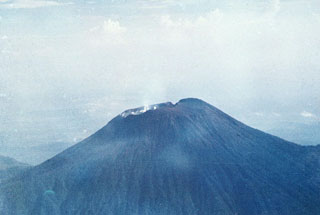Report on Slamet (Indonesia) — May 2009
Bulletin of the Global Volcanism Network, vol. 34, no. 5 (May 2009)
Managing Editor: Richard Wunderman.
Slamet (Indonesia) During April-June 2009, minor explosive eruptions with occasional lava fountains
Please cite this report as:
Global Volcanism Program, 2009. Report on Slamet (Indonesia) (Wunderman, R., ed.). Bulletin of the Global Volcanism Network, 34:5. Smithsonian Institution. https://doi.org/10.5479/si.GVP.BGVN200905-263180
Slamet
Indonesia
7.242°S, 109.208°E; summit elev. 3428 m
All times are local (unless otherwise noted)
Minor eruptions were reported at the active crater during April-June 2009. Small amounts of ash fell several times during May. Witnesses saw lava fountains on 12 and 21-23 May. Previously, steam plumes were associated with heavy rains during 28 March-3 April 2007 (BGVN 33:04).
During 19-23 April 2009 Slamet's seismicity increased. On 20 April, diffuse white plumes rose ~ 50 m above the crater. During 21-23 April, the number of eruption tremors increased steadily, and dense, white-to-brownish plumes rose 50-800 m above the crater rim. The Alert Level was raised to 2 (on a scale of 1-4).
On 23 April, the Alert Level was raised to 3; people were advised not to climb the summit. According to a news article in the Jakarta Globe, a volcanologist from the Center of Volcanology and Geological Hazard Mitigation (CVGHM) stated that lava was ejected 600 m high and ash bursts occurred up to 112 times within a 6-hour period.
According to CVGHM, seismicity continued to increase or remain elevated during 23 April-17 May, peaking on 17 May. During this period, continuous eruptive quakes/tremors were recorded, together with an increase in amplitude (3-46 mm on 12-13 May, rising to about 20-32 mm between 17-24 May). Eruptions from the western part of the crater continued, and inflation was noted. During times of clear weather, observers reported that incandescent lava was ejected 25-100 m above the crater, and then fell back into and around the active crater. Gray and white "smoke" rose 100-800 m from the crater. Occasionally a thunderous noise accompanying eruptions of ash occurred, and ashfall was detected in areas 5-9 km away. The temperature of water in several locations on the flanks increased.
During 12 May and 21-23 May, lava fountains rose 100-400 m above the crater rim. During several eruptions, ejected incandescent material traveled down the W flank. White-to-gray "smoke" rose 150 m above the crater. On 22 May, ashfall was reported in Sawangan village, 5 km W. On 23 May, an ash plume rose 1 km above the crater and ash fell on the N flank. Ash accumulated to 1 mm depth near the observation post. The next day an ash plume rose 700 m above the crater.
Based on ground information from CVGHM, the Darwin Volcanic Ash Advisory Centre (VAAC) reported that on 27 May an ash plume from Slamet rose to an altitude of 4.3 km. Analysis of satellite imagery also indicated that a possible plume rose to an altitude of 6.1 km, but ash was not conclusively detected.
CVGHM reported that during 26 May-4 June activity from Slamet fluctuated, but decreased overall. They found decreases in both the number of earthquakes and the temperature of water in areas around the volcano. Inflation and deflation fluctuated within a range of 2 cm. White plumes rose 100-750. During 5-7 June, activity was characterized by inflation and an increased number of earthquakes. During that time, white plumes were accompanied by ash emissions that rose 200-800 m from the crater, incandescent material was ejected 50-200 m above the crater, and booming noises were reported.
As of 4 June 2009, the Alert Level remained at 3, based on visual data, deformation, earthquakes, and tremor. CVGHM urged the public to don face masks during heavy ashfalls, and to cover water sources to prevent contamination by volcanic ash.
Geological Summary. Slamet is one of Java's most active volcanoes. It has a cluster of about three dozen cinder cones on its lower SE-NE flanks and a single cinder cone on the W flank. It is composed of two overlapping edifices, an older basaltic andesite to andesitic volcano on the west and a younger basaltic to basaltic andesite one on the east. Gunung Malang II cinder cone on the upper E flank on the younger edifice fed a lava flow that extends 6 km E. Four craters occur at the summit of Gunung Slamet, with activity migrating to the SW over time. Eruptions recorded since the 18th century have originated from a 150-m-deep, 450-m-wide, steep-walled crater at the western part of the summit and have consisted of explosive eruptions generally lasting a few days to a few weeks.
Information Contacts: Center of Volcanology and Geological Hazard Mitigation (CVGHM), Jalan Diponegoro 57, Bandung 40122, Indonesia (URL: http://vsi.esdm.go.id/); Darwin Volcanic Ash Advisory Centre (VAAC), Bureau of Meteorology, Northern Territory Regional Office, PO Box 40050, Casuarina, NT 0811, Australia (URL: http://www.bom.gov.au/info/vaac/); Jakarta Globe (URL: http://www.thejakartaglobe.com).

